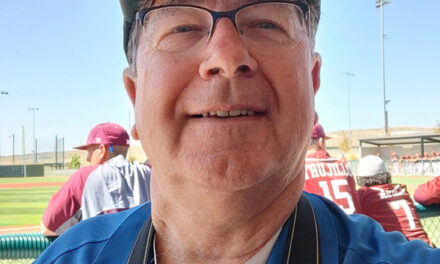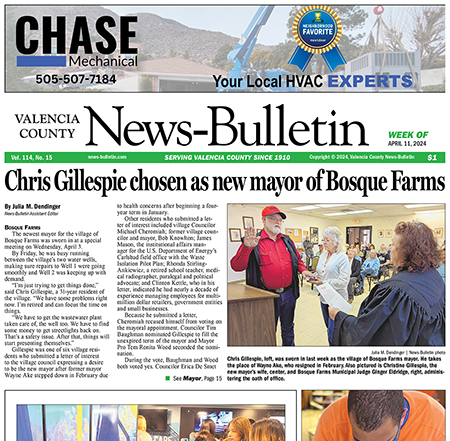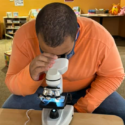
Naithan Gurule
Los Lunas Police Chief
In light of what is happening across the country, I have recently been asked many questions regarding Los Lunas Police Department procedures. I feel there are four important areas in which a department must focus to ensure a healthy and transparent relationship with its community.
These four areas are body-worn cameras, Early Intervention Personnel Systems, Citizen Complaint Systems and Use-of-Force Policies and Review Procedures, with training intertwined into each category.
Each of these categories is an important part of a checks and balances type system. It is also important to understand that any system is only as good as the effort each person puts into it. These measures protect the citizens and the officers, and they significantly reduce lawsuits and settlements.
Body-worn cameras
The Los Lunas Police Department has been using body worn cameras for about 10 years. We began with a very simple MUVI brand camera. A few years ago, we began to upgrade with the help of the village’s insurance carrier, the New Mexico Municipal League, who were offering departments throughout the state reimbursement for the purchase of cameras.
The body-worn cameras benefits are dependent on proper use. The proper usage is dependent on a good policy that department personnel are required to adhere to.
Studies show the benefits of BWC outweigh any challenge an agency might face not having a body-worn camera program. In my experience, the body-worn cameras have been a valuable tool for many different reasons.
The cameras’ recordings provide us the opportunity to more thoroughly evaluate officers’ tactics. This process is similar to what a coach does to evaluate players, ensuring they continue to be as safe and efficient as possible. We are able to better document crimes and crime scenes with the camera recordings.
The camera recordings have proven to be an invaluable tool when investigating citizen complaints and officer use-of-force cases. More times than not, the camera recordings have exonerated the officers. The use of body-worn cameras has provided a large return on investment because they have helped to reduce the number lawsuits and settlements.
Early Intervention Personnel System
The Early Intervention Personnel System is designed to proactively and systematically review certain employee work behaviors (uses of force, complaints, sick leave, crashes, failure to activate body-worn camera, awards and commendations) for possible indicators of performance or stress-related problems, to assist employees who may benefit from departmental intervention.
The emphasis of the EIPS is on training and coaching, and is designed as a system to assist supervisory personnel in evaluating and guiding the employee.
Complaint System
As is stated on our website, “It is the policy of the Los Lunas Police Department to investigate all complaints against department employees and allegations of misconduct within the department. Proper adherence to the provisions of this policy will clear the innocent and facilitate prompt and equitable corrective action.”
The Los Lunas Police Department recognizes community trust is gained through transparency and accountability. Unfortunately, there are still departments in our country that shy away from taking citizen complaints unless a complainant is willing to sign their name on an official complaint form.
The LLPD investigates, logs and tracks all citizen complaints. Most complaints are investigated by the officer’s immediate supervisor, with the more serious complaints being handled by the department’s internal affairs.
Our lieutenants have received training related to conducting administrative investigations and are actively involved in most investigations. During any administrative investigation, the investigator will review all evidence available to them, to include body-camera footage, incident reports, witness statements, etc. If necessary, the investigator will interview the officer, but there are instances where the officer will not need to be interviewed.
When body-worn camera footage clearly exonerates an officer of any wrongdoing, there is no need to interview them. For example, recently we had a citizen complain that she was assaulted by one of our officers. The body-worn camera footage from this officer depicted his entire contact with the complainant, and at no time did he use force on the complainant. This was corroborated by witnesses on scene as well as building surveillance from a nearby business.
Nevertheless, this complaint was thoroughly investigated and the complainant was provided with the very evidence we utilized during the investigation.
Once an investigation is completed, and the chief has reviewed its findings, we will notify the complainant in writing. The complaint is then logged into the department’s Early Intervention Personnel System.
Use-of-Force Policies and Review Procedures
American law enforcement currently does not have a standard definition of use of force. Departments use varying definitions of use of force, ranging from force that is anything more than un-resisted handcuffing to believing force was used only if an injury occurred. American law enforcement also does not have a use of force reporting standard. Agency reporting requirements range from a requirement to report un-resisted handcuffing to reporting only if an injury occurs.
Generally, use-of-force reporting requirements are similar to the definitions of use of force. The lack of both a standard definition and a reporting standard for use of force generates a lack of oversight.
Because the spectrum of reporting requirements is so broad, not every agency is sufficiently examining use of force by their police officers. The Los Lunas Police Department requires a thorough investigation when any officer(s) use force greater than un-resisted handcuffing or a firm grip. This helps us to closely monitor all officers to ensure they are utilizing force according to state law and departmental procedure.
The Los Lunas Police Department has in-house trainers in the subject of use of force to include myself, the deputy chief and several other supervisors. The deputy chief’s bachelor’s degree Capstone Project was on use of force; my bachelor’s degree Capstone Project and my master’s degree thesis was also on use of force.
Our department conducts a yearly policy review for use of force and requires training and certification in the use of less lethal force/weapons and the use of deadly force. We track and examine uses of force by officers utilizing the Early Intervention Personnel System to alert us to potential problematic behavior.
All of our officers have attended crisis intervention/de-escalation training. We have in-house instructors to teach de-escalation training. This training is ongoing and helps our officers during encounters with those who are mentally ill, intoxicated or under the influence of drugs.
In conclusion, I feel it is important for a police department to be open to the needs and concerns of its community. To the citizens of our community, your police department is always open to new ideas to help ensure we continue to be a progressive department.
A law enforcement agency must always strive to be cutting edge and ahead of the curve. We can’t wait for something to happen before we make changes; if we do that, we’ve already lost.
Your Los Lunas police officers stand ready and work hard daily to ensure the safety and success of our wonderful community, and I am incredibly proud to be a part of it.
Additional Q&A
Q How does LLPD approach people who are victims of sexual assault and domestic violence? What protocols do officers use and what agencies do they utilize, if any?
A “We regularly work with the SANE (Sexual Assault Nurse Examiners) Unit, the domestic violence shelter as well as the Valencia County domestic violence advocates.
“We are proud to have participated in a new program, which requires our officers to complete a lethality assessment during these types of calls. The lethality assessments have assisted the district attorney’s office in having more successful prosecutions for these types of cases. We are now a model agency and helping to train other agencies within the county.”
Q How does the Los Lunas Police Department handle homeless people?
A “If, in fact, our officers encounter a homeless person, we treat them with the dignity and respect that we would treat any other member of our community. If an officer is called to a location where someone is asleep, we would check on their welfare to ensure they are okay. “If they needed any further resources, we would do all we could to put them into contact with them such as the Salvation Army, etc. We have had instances in which our officers have purchased shoes, bought food or rented hotel rooms out of their own pocket for the homeless.”
Q How does LLPD address immigration — is ICE called? What steps are taken if someone is undocumented? What is their policy?
A “The Los Lunas Police Department does not address a person’s immigration status. I do not know what ICE’s policy is.”
Q How does the Los Lunas Police Department handle protesters and rallies/civil militia groups?
A “With regard to protests/rallies, and militia groups, we would follow our standard operating procedures and police the situation as we would handle any other situation or call for service. We will, of course, do our best to de-escalate and keep the peace.
“Should a peaceful/lawful protest occur, we will support and assist them in any way we can. In the event we have people who decide to commit a crime, such as damage property, we will handle it accordingly.”
Q What changes is the department is considering in the coming months pertinent to the use of militaristic equipment?
A “ … I do not know what you consider to be militaristic equipment but if you are referring to the use of rifles and the use of our armored vehicle, we are not considering any changes. These tools are important to our community so that we can better protect them from incidents, such as active shooters, school shootings, etc.
“This year, I will have six children at two different school sites, and personally know several other children from coaching, etc., at various other Los Lunas schools. Knowing the Los Lunas Police Department is responsible for responding to these school sites is adequately armed and trained, provides me with confidence and comfort.”
Q How does LLPD address transparency with the public and how (can) we obtain information about police violence accounts, the budget for our respective law enforcement departments, and what kinds of training LLPD receives?
A “The Village of Los Lunas budget is all public record. The budget is on the village website’s. We publish an annual report every year, which covers use of force, complaints, etc …”
Q How does LLPD approach people who are under the influence of drugs and having difficulty — both for DUIs and for people harmlessly in public — and do officers carry NARCAN?
A “All Los Lunas Police Department officers carry NARCAN, per state law.”
(Los Lunas Police Chief Naithan Gurule grew up in Los Lunas and graduated from Los Lunas High School in 1999. His wife, Carolina, also graduated from Los Lunas High School in 2001. They were married in December 2001, and have six children together (four boys and two girls). This year, they will have a senior, a junior and a freshman in high school, along with a sixth-grader, a third-grader grader and first-grader. Their children have been involved in sports since they were young, and he’s had the opportunity to coach sports within the community.
Gurule’s father’s side of the family has lived in this community for generations. A positive from all of this is he knows a majority of community members personally.
Gurule has been with the Los Lunas Police Department since July 2002. During that time, he was able to obtain his Bachelor’s degree in Criminal Justice, Master’s degree in Criminal Justice, attended the FBI National Academy and the Northwestern University School of Police Staff and Command.)














